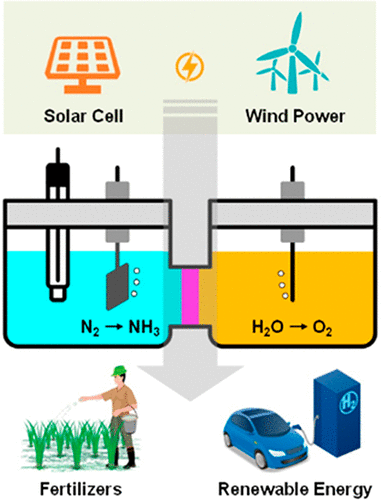当前位置:
X-MOL 学术
›
Chem. Rev.
›
论文详情
Our official English website, www.x-mol.net, welcomes your
feedback! (Note: you will need to create a separate account there.)
Recent Advances and Challenges of Electrocatalytic N2 Reduction to Ammonia.
Chemical Reviews ( IF 51.4 ) Pub Date : 2020-05-27 , DOI: 10.1021/acs.chemrev.9b00659 Geletu Qing 1 , Reza Ghazfar 1 , Shane T Jackowski 1 , Faezeh Habibzadeh 1 , Mona Maleka Ashtiani 1 , Chuan-Pin Chen 1 , Milton R Smith 1 , Thomas W Hamann 1
Chemical Reviews ( IF 51.4 ) Pub Date : 2020-05-27 , DOI: 10.1021/acs.chemrev.9b00659 Geletu Qing 1 , Reza Ghazfar 1 , Shane T Jackowski 1 , Faezeh Habibzadeh 1 , Mona Maleka Ashtiani 1 , Chuan-Pin Chen 1 , Milton R Smith 1 , Thomas W Hamann 1
Affiliation

|
Global ammonia production reached 175 million metric tons in 2016, 90% of which is produced from high purity N2 and H2 gases at high temperatures and pressures via the Haber–Bosch process. Reliance on natural gas for H2 production results in large energy consumption and CO2 emissions. Concerns of human-induced climate change are spurring an international scientific effort to explore new approaches to ammonia production and reduce its carbon footprint. Electrocatalytic N2 reduction to ammonia is an attractive alternative that can potentially enable ammonia synthesis under milder conditions in small-scale, distributed, and on-site electrolysis cells powered by renewable electricity generated from solar or wind sources. This review provides a comprehensive account of theoretical and experimental studies on electrochemical nitrogen fixation with a focus on the low selectivity for reduction of N2 to ammonia versus protons to H2. A detailed introduction to ammonia detection methods and the execution of control experiments is given as they are crucial to the accurate reporting of experimental findings. The main part of this review focuses on theoretical and experimental progress that has been achieved under a range of conditions. Finally, comments on current challenges and potential opportunities in this field are provided.
中文翻译:

电催化氮还原为氨的最新进展和挑战。
2016年,全球氨气产量达到1.75亿吨,其中90%是通过Haber–Bosch工艺在高温和高压下由高纯度N 2和H 2气体产生的。依靠天然气生产H 2会导致大量能源消耗和CO 2排放。对人为引起的气候变化的担忧促使国际间开展科学努力,以探索生产氨的新方法并减少其碳足迹。电催化N 2还原成氨是一种有吸引力的替代方法,它可以在较温和的条件下,在由太阳能或风能产生的可再生电力驱动的小规模,分布式和现场电解槽中,实现氨的合成。这篇综述提供了有关电化学固氮的理论和实验研究的全面介绍,重点是还原N 2还原为氨与质子还原为H 2的低选择性。。详细介绍了氨气检测方法和控制实验的执行,因为它们对于准确报告实验结果至关重要。本文的主要内容集中在一系列条件下取得的理论和实验进展。最后,提供了有关该领域当前挑战和潜在机会的评论。
更新日期:2020-06-24
中文翻译:

电催化氮还原为氨的最新进展和挑战。
2016年,全球氨气产量达到1.75亿吨,其中90%是通过Haber–Bosch工艺在高温和高压下由高纯度N 2和H 2气体产生的。依靠天然气生产H 2会导致大量能源消耗和CO 2排放。对人为引起的气候变化的担忧促使国际间开展科学努力,以探索生产氨的新方法并减少其碳足迹。电催化N 2还原成氨是一种有吸引力的替代方法,它可以在较温和的条件下,在由太阳能或风能产生的可再生电力驱动的小规模,分布式和现场电解槽中,实现氨的合成。这篇综述提供了有关电化学固氮的理论和实验研究的全面介绍,重点是还原N 2还原为氨与质子还原为H 2的低选择性。。详细介绍了氨气检测方法和控制实验的执行,因为它们对于准确报告实验结果至关重要。本文的主要内容集中在一系列条件下取得的理论和实验进展。最后,提供了有关该领域当前挑战和潜在机会的评论。











































 京公网安备 11010802027423号
京公网安备 11010802027423号